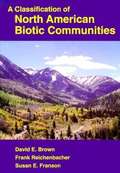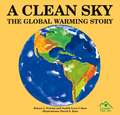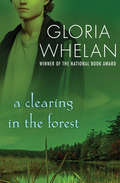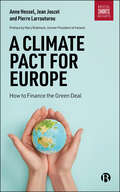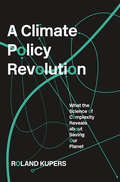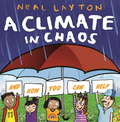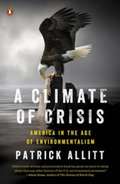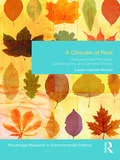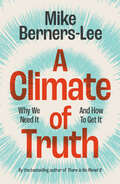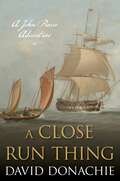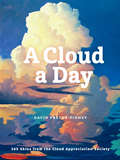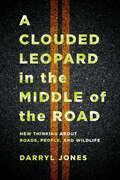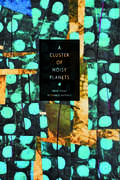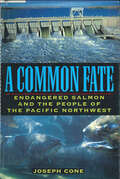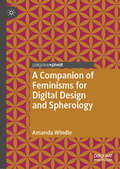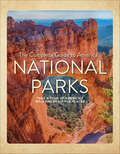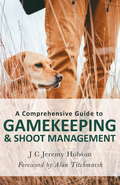- Table View
- List View
A Classification of North American Biotic Communities
by David E. Brown Frank Reichenbacher Susan E. FransonBuilding upon existing classification systems of natural environments, this visually-oriented guide--from the Arctic Circle to Central America--advocates a universal, biogeographic standard for inventorying regional.
A Clean Sky: The Global Warming Story
by Judith Love Cohen Robyn C. FriendAn introduction for children to the importance of preserving the environment and the significant effects that global warming can have on nature.
A Clear Flowing Yarra
by Harry SaddlerThey say you can't step in the same river twice, and it's true that the Yarra has been hugely changed - but this book is a glorious and timely reminder that things can also be changed for the better.Nature writer Harry Saddler hops, skips and jumps his way along, beside, on and even in the Yarra River from source to mouth, reveling in its hidden beauty, getting close to platypuses, kingfishers, Krefft's gliders and the occasional seal, and meeting many of the swimmers, bushwalkers, ecologists and traditional owners who are quietly and tenaciously restoring the river, patch by patch.Optimistic, inspiring and heartfelt, A Clear Flowing Yarra is a passionate love letter to the river that shapes Melbourne, and an evocative vision of what it is now and what it can be.
A Clear Flowing Yarra
by Harry SaddlerThey say you can't step in the same river twice, and it's true that the Yarra has been hugely changed - but this book is a glorious and timely reminder that things can also be changed for the better.Nature writer Harry Saddler hops, skips and jumps his way along, beside, on and even in the Yarra River from source to mouth, reveling in its hidden beauty, getting close to platypuses, kingfishers, Krefft's gliders and the occasional seal, and meeting many of the swimmers, bushwalkers, ecologists and traditional owners who are quietly and tenaciously restoring the river, patch by patch.Optimistic, inspiring and heartfelt, A Clear Flowing Yarra is a passionate love letter to the river that shapes Melbourne, and an evocative vision of what it is now and what it can be.
A Clearing in the Forest
by Gloria WhelanAn elderly woman and a young boy team up to save the countryside Old Frances Crawford is looking for wild mushrooms when she hears the gunshot. A few minutes later, the teenage hunter blunders into her clearing, two dead rabbits over his shoulder. As an apology for hunting on her land, Wilson offers her one of the rabbits, and Frances is happy to take it. She hasn&’t been able to afford meat for some time. He is handing it over when she falls at his feet in a dead faint. Wilson carries Frances home and the two get to talking—about fossils, about the woods, about the best way to cook rabbit with wild mushrooms. Soon this tough old lady is teaching Wilson everything she knows about the forests of Northern Michigan. When an oil company threatens to destroy the natural landscape, these unlikely friends will work to save the woods that brought them together.
A Climate Pact for Europe: How to Finance the Green Deal
by Jean Jouzel Anne HesselThe COVID-19 pandemic gives an opportunity to relaunch global economic systems with a better balance between the social and environmental dimensions. There is a need for a scientifically-based step towards a strong Green Deal: a Climate Pact for the EU. Based on a bestselling French book, this English translation provides a summary of the facts on the climate issue, the solutions available and their costs. It outlines the political advantages and challenges current policy, practice and thinking at a time when populist leaders are transforming politics worldwide. This timely book will contribute to a renewed political vision for the EU, the European Economic Area, the UK and Africa.
A Climate Policy Revolution: What the Science of Complexity Reveals about Saving Our Planet
by Roland KupersHumanity’s best hope for confronting the looming climate crisis rests with the new science of complexity. The sheer complexity of climate change stops most solutions in their tracks. How do we give up fossil fuels when energy is connected to everything, from great-power contests to the value of your pension? Global economic growth depends on consumption, but that also produces the garbage now choking the oceans. To give up cars, coal, or meat would upend industries and entire ways of life. Faced with seemingly impossible tradeoffs, politicians dither and economists offer solutions at the margins, all while we flirt with the sixth extinction. That’s why humanity’s last best hope is the young science of complex systems. Quitting coal, making autonomous cars ubiquitous, ending the middle-class addiction to consumption: all necessary to head off climate catastrophe, all deemed fantasies by pundits and policymakers, and all plausible in a complex systems view. Roland Kupers shows how we have already broken the interwoven path dependencies that make fundamental change so daunting. Consider the mid-2000s, when, against all predictions, the United States rapidly switched from a reliance on coal primarily to natural gas. The change required targeted regulations, a few lone investors, independent researchers, and generous technology subsidies. But in a stunningly short period of time, shale oil nudged out coal, and carbon dioxide emissions dropped by 10 percent. Kupers shows how to replicate such patterns in order to improve transit, reduce plastics consumption, and temper the environmental impact of middle-class diets. Whether dissecting China’s Ecological Civilization or the United States’ Green New Deal, Kupers describes what’s folly, what’s possible, and which solutions just might work.
A Climate in Chaos: and how you can help
by Neal LaytonYou've probably heard about climate change. At least I hope you have - because it's REALLY IMPORTANT. It affects all of us living on Planet Earth right now, and everyone and everything that will live on our planet in the future.Our world is warming up, and it's a big problem. Award-winning author-illustrator Neal Layton is here to explain what climate change is, what's causing it and why it's dangerous for animals and humans alike. But he's also FULL of ideas for how you can help! From eating lots more veggies to walking and cycling and thinking carefully about what we need to buy, A Climate in Chaos will get young readers excited about how they can make a difference to keep Planet Earth happy.This brilliant non-fiction picture book, illustrated in Neal's trademark collage style, is perfect for readers aged 5-7 who love nature and want to help the environment.Also available in this series: A Planet Full of Plastic.
A Climate of Crisis
by Patrick AllittA provocative history of the environmental movement in America, showing how this rise to political and social prominence produced a culture of alarmism that has often distorted the facts Few issues today excite more passion or alarm than the specter of climate change. In A Climate of Crisis, historian Patrick Allitt shows that our present climate of crisis is far from exceptional. Indeed, the environmental debates of the last half century are defined by exaggeration and fearmongering from all sides, often at the expense of the facts. In a real sense, Allitt shows us, collective anxiety about widespread environmental danger began with the atomic bomb. As postwar suburbanization transformed the American landscape, more research and better tools for measurement began to reveal the consequences of economic success. A climate of anxiety became a climate of alarm, often at odds with reality. the sixties generation transformed environmentalism from a set of special interests into a mass movement. by the first Earth Day in 1970, journalists and politicians alike were urging major initiatives to remedy environmental harm. In fact, the work of the new Environmental Protection Agency and a series of clean air and water acts from a responsive Congress inaugurated a largely successful cleanup. Political polarization around environmental questions after 1980 had consequences that we still feel today. Since then, the general polarization of American politics has mirrored that of environmental politics, as pro-environmentalists and their critics attribute to one another the worst possible motives. Environmentalists see their critics as greedy special interest groups that show no conscience as they plunder the earth while skeptics see their adversaries as enemies of economic growth whose plans stifle initiative under an avalanche of bureaucratic regulation. There may be a germ of truth in both views, but more than a germ of falsehood too. America's worst environmental problems have proven to be manageable; the regulations and cleanups of the last sixty years have often worked, and science and technology have continued to improve industrial efficiency. Our present situation is serious, argues Allitt, but it is far from hopeless. Sweeping and provocative, A Climate of Crisis challenges our basic assumptions about the environment, no matter where we fall along the spectrum--reminding us that the answers to our most pressing questions are sometimes found in understanding the past.
A Climate of Crisis: America in the Age of Environmentalism
by Patrick AllittA provocative history of the environmental movement in America, showing how this rise to political and social prominence produced a culture of alarmism that has often distorted the factsFew issues today excite more passion or alarm than the specter of climate change. In A Climate of Crisis, historian Patrick Allitt shows that our present climate of crisis is far from exceptional. Indeed, the environmental debates of the last half century are defined by exaggeration and fearmongering from all sides, often at the expense of the facts. In a real sense, Allitt shows us, collective anxiety about widespread environmental danger began with the atomic bomb. As postwar suburbanization transformed the American landscape, more research and better tools for measurement began to reveal the consequences of economic success. A climate of anxiety became a climate of alarm, often at odds with reality. The sixties generation transformed environmentalism from a set of special interests into a mass movement. By the first Earth Day in 1970, journalists and politicians alike were urging major initiatives to remedy environmental harm. In fact, the work of the new Environmental Protection Agency and a series of clean air and water acts from a responsive Congress inaugurated a largely successful cleanup. Political polarization around environmental questions after 1980 had consequences that we still feel today. Since then, the general polarization of American politics has mirrored that of environmental politics, as pro-environmentalists and their critics attribute to one another the worst possible motives. Environmentalists see their critics as greedy special interest groups that show no conscience as they plunder the earth while skeptics see their adversaries as enemies of economic growth whose plans stifle initiative under an avalanche of bureaucratic regulation. There may be a germ of truth in both views, but more than a germ of falsehood too. America’s worst environmental problems have proven to be manageable; the regulations and cleanups of the last sixty years have often worked, and science and technology have continued to improve industrial efficiency. Our present situation is serious, argues Allitt, but it is far from hopeless. Sweeping and provocative, A Climate of Crisis challenges our basic assumptions about the environment, no matter where we fall along the spectrum—reminding us that the answers to our most pressing questions are sometimes found in understanding the past.From the Trade Paperback edition.
A Climate of Risk: Precautionary Principles, Catastrophes, and Climate Change (Environmental Politics)
by Lauren Hartzell-NicholsWe are living in a climate of risk. Our way of life imposes risks on ourselves and others. We are causing climatic changes that have the potential to change radically the conditions under which both we – the present generation – and future generations will live. While we are now quite certain that climate change is happening, we are unsure of exactly what will happen and when, given different emissions and policy scenarios. We are therefore in a position where we must decide what to do about the risks climate change threatens in the face of a range of uncertainties In this book, Lauren Hartzell-Nichols provides guidance in the face of this uncertainty by offering an in-depth discussion of how and why we ought to take a precautionary approach to climate policy, namely by appeal to a Catastrophic Precautionary Principle and Catastrophic Precautionary Decision-Making Framework. By examining the way in which climate change is harmful, Hartzell-Nichols shows how precaution does have a meaningful role to play in moving climate policy forward if we reconsider what precaution is about before too quickly appealing to precaution as a reason or justification for action. A Climate of Risk takes a philosophically grounded, interdisciplinary approach that will appeal to a broad scholarly and policy-oriented audience. Hartzell-Nichols’s reinterpretation of the precautionary principle enables precaution to be more effectively leveraged as a driver of action on climate change.
A Climate of Truth: Why We Need It and How To Get It
by Mike Berners-LeeWe have most of the technology we need to combat the climate crisis - and most people want to see more action. But after three decades of climate COPs, we are accelerating into a polycrisis of climate, food security, biodiversity, pollution, inequality, and more. What, exactly, has been holding us back? Mike Berners-Lee looks at the challenge from new angles. He stands further back to gain perspective; he digs deeper under the surface to see the root causes; he joins up every element of the challenge; and he learns lessons from our failures of the past. He spells out why, if humanity is to thrive in the future, the most critical step is to raise standards of honesty in our politics, our media, and our businesses. Anyone asking 'what can each of us do right now to help?' will find inspiration in this practical and important book.
A Close Run Thing: A John Pearce Adventure (John Pearce)
by David DonachieThe fifteenth volume in the popular John Pearce Adventures set on the high seas1796: Lieutenant John Pearce is hiding in the smugglers&’ hub of Gravelines with his mysterious companion, known only to him as Oliphant, trapped in French territory with no way out. Although they find a crew willing to take them to England, they discover on the journey that Pearce&’s old enemies, the Tolland brothers, are still active on the route and danger may be lurking close to shore.While being in his homeland brings Pearce closer to Emily Barclay and their young son, Adam, the constant need for discretion is an additional strain on their already fragile relationship. Then, just as things may be looking up, it seems Henry Dundas has another role for him and Oliphant: a mission to north-east Spain.
A Cloud a Day: 365 Skies from the Cloud Appreciation Society
by Gavin Pretor-Pinney&“[A] year&’s worth of everything from Cirrus fibratus to Cumulo-stratus . . . reminds us that self-care is as available as a glance out the window.&” —The New York Times (Holiday Gift Pick) Cloudspotter and bestselling author Gavin Pretor-Pinney delivers a moment of calm atmospheric contemplation to members of his Cloud Appreciation Society by sharing a cloud image and story every day. A Cloud a Day urges all of us to keep our heads in the clouds with 365 fascinating formations from his extraordinarily popular Cloud Appreciation Society collection. Inspirational quotes and informative cloud facts accompany provocative and meditative images of the sky, encouraging readers to pause for a moment and look up. A beautifully illustrated book, A Cloud a Day makes a wonderful gift for dedicated or erstwhile cloudspotters—as for any of us with our heads lost in them. &“In his introduction, Pretor-Pinney explains that we live upon an ocean of gasses, and that it would improve the quality of our lives to spend a bit of time noticing that ever-changing ocean around us. After perusing this enlightening book, many readers will agree.&” —BookPage &“This meditative book gives you a daily dose of quotes, facts, and of course, clouds. Perfect for someone who you&’d like to encourage to look up, or whose head is in the clouds most of the time anyway.&” —Read Now Sleep Later &“If you&’re not interested in the science, the book will endear itself to you for the photographs, paintings, and prints it contains.&” —The Backroom
A Clouded Leopard in the Middle of the Road: New Thinking about Roads, People, and Wildlife
by Darryl JonesA Clouded Leopard in the Middle of the Road is an eye-opening introduction to the ecological impacts of roads. Drawing on over ten years of active engagement in the field of road ecology, Darryl Jones sheds light on the challenges roads pose to wildlife—and the solutions taken to address them. One of the most ubiquitous indicators of human activity, roads typically promise development and prosperity. Yet they carry with them the threat of disruption to both human and animal lives. Jones surveys the myriad, innovative ways stakeholders across the world have sought to reduce animal-vehicle collisions and minimize road-crossing risks for wildlife, including efforts undertaken at the famed fauna overpasses of Banff National Park, the Singapore Eco-Link, "tunnels of love" in the Australian Alps, and others. Along the way, he acquaints readers with concepts and research in road ecology, describing the field's origins and future directions. Engaging and accessible, A Clouded Leopard in the Middle of the Road brings to the foreground an often-overlooked facet of humanity's footprint on earth.
A Clown at Midnight: Poems
by Andrew Hudgins“Recklessness and rigor, in equal measure, mark the stirring poetics of Andrew Hudgins in this fine new book. Hudgins can wrestle a rhyme scheme into submission with one hand tied behind his back and can penetrate the black heart of history with a single, subtly rendered detail. He laughs with Democritus and weeps with Heraclitus and, line by distillate line, contrives a tonic antidote to “the acetone / of American inattention.” — Linda GregersonIn A Clown at Midnight Andrew Hudgins offers a meditation on humor with a refreshing poignancy and cutting wit. He touches on love and nature, but at its core this collection is about the consolations and terrors, the delights and discomforts, of laughter, taking its title from a quote by Lon Chaney Sr.: “The essence of true horror is a clown at midnight.” Skillfully probing paradoxes, Hudgins conjures the titular clown: “Down these mean streets a bad joke walks alone / bruised head held low, chin tucked in tight, eyes down / defiant. He laughs and it turns to a moan.” Hudgins gives us utter honesty and accessible verse, exploring moments both uncomfortable and satirical while probing the impulse to confront life’s most demanding trials with laughter.“Hudgins’s poems are often funny, hinging on a joke or wisecrack or malapropism, but human nature red in tooth and claw has always been his greatest theme.” — BookPage
A Cluster of Noisy Planets
by Charles RaffertyCharles Rafferty’s latest collection of prose poems turns philosophical. In A Cluster of Noisy Planets, Rafferty captures the rhythms and patterns of life as a lover, father, and poet, distilling each moment to its essence and grounding them collectively in the wider perspective of a changing world, the constant turning of the stars and the changing seasons of the New England countryside. With a knowing nod to the passage of time—day to day, year to year, epoch to epoch—these lyrical poems form a record of the profound, ephemeral joys, losses, and echoes of commonplace moments.
A Cold Welcome: The Little Ice Age and Europe’s Encounter with North America
by Sam WhiteWhen Europeans arrived in North America, the average global temperature had dropped to lows unseen in millennia and its effects—famine, starvation, desperation, and violence—were stark among colonists unprepared to fend for themselves. This history of the Little Ice Age in North America reminds us of the risks of a changing and unfamiliar climate.
A Common Fate: Endangered Salmon and the People of the Pacific Northwest
by Joseph ConeThough life on earth is the history of dynamic interactions between living things and their surroundings, certain powerful groups would have us believe that nature exists only for our convenience. One consequence of such thinking is the apparent fate of the Pacific salmon--a key resource and preeminent symbol of America's wildlife--which is today threatened with extinction. Drawing on abundant data from natural science, Pacific coast culture, and a long association with key individuals on all sides of the issue, Joseph Cone's A Common Fate employs a clear narrative voice to tell the human and natural history of an environmental crisis in its final chapter.As inevitable as the November rains, countless millions of wild salmon returned from the ocean to spawn in the streams of their birth. In the wake of an orgy of dam building and habitat destruction, the salmon's majestic abundance has been reduced to a fleeting shadow. Neglect is the word the author uses to describe more recent losses, "by exactly the ones--state and federal fish managers--who should have acted."To signal a new awareness that action is needed, scientists charged with restocking the Columbia River Basin are receiving significant support, while ordinary citizens are beginning to recognize the relationship between cheap power and the absences of chinook, coho, sockeye, and other species from the coasts of Oregon and Washington and from Idaho's Snake River. As desperate as the salmon's future appears, the book is not an elegy for a lost resource. Instead, it bears witness to hope. In addition to concrete plans for the wild salmon's renewal, the reader will hear a growing chorus of informed individuals of differing values and beliefs who recognize that our fate is inextricably bound to the salmon's; for many it is a new understanding.
A Companion of Feminisms for Digital Design and Spherology
by Amanda Windle<p>This book questions if spherology is a philosophy for designers, giving guidance on ways to read Spheres, how to approach the trilogy’s indexicality, and apply the key tropes and ethics of atmospheres to digital design. Each chapter includes a design-in, that is a practical entry point into the many tropes of Spheres including― bubbles, globes and foam. The book also applies spherology to an atmosphere design issue involving endangered species and geospatial threats to the environment. <p>Spherology refers to the Spheres trilogy by the philosopher Peter Sloterdijk, which traces spherical ideas, theories, sensations and feelings related to the philosophical concept of ‘being’ and the human-centered position of ‘being-in’. It is the first cynical, feminist companion of spherology to take a practice-led approach and to cover all three controversial volumes to with and against Spheres. Windle draws on feminist science and technology studies (STS) through parody within reading, writing and design practices. Design provides navigation so that academics and students can engage with spherology through an embodied concern with digital materiality. <p>As a feminist companion for today’s design issues, the book is an essential read for feminist STS scholars, design practitioners and digital R&D specialists working both in industry and academia, including more specifically data visualisers, interface and interaction designers.</p>
A Comparative Political Ecology of Exurbia: Planning, Environmental Management, and Landscape Change
by Laura E. Taylor Patrick T. HurleyThis book is about politics and planning outside of cities, where urban political economy and planning theories do not account for the resilience of places that are no longer rural and where local communities work hard to keep from ever becoming urban. By examining exurbia as a type of place that is no longer simply rural or only tied to the economies of global resources (e. g. , mining, forestry, and agriculture), we explore how changing landscapes are planned and designed not to be urban, that is, to look, function, and feel different from cities and suburbs in spite of new home development and real estate speculation. The book's authors contend that exurbia is defined by the persistence of rural economies, the conservation of rural character, and protection of natural ecological systems, all of which are critical components of the contentious local politics that seek to limit growth. Comparative political ecology is used as an organizing concept throughout the book to describe the nature of exurban areas in the U. S. and Australia, although exurbs are common to many countries. The essays each describe distinctive case studies, with each chapter using the key concepts of competing rural capitalisms and uneven environmental management to describe the politics of exurban change. This systematic analysis makes the processes of exurban change easier to see and understand. Based on these case studies, seven characteristics of exurban places are identified: rural character, access, local economic change, ideologies of nature, changes in land management, coalition-building, and land-use planning. This book will be of interest to those who study planning, conservation, and land development issues, especially in areas of high natural amenity or environmental value. There is no political ecology book quite like this--neither one solely focused on cases from the developed world (in this case the United States and Australia), nor one that specifically harnesses different case studies from multiple areas to develop a central organizing perspective of landscape change.
A Complete Guide to America's National Parks: Take a Tour of America's Wild and Beautiful Places
by Nancy J. HajeskiSince 1872, when Yellowstone became America&’s inaugural national park, these protected areas have enthralled visitors from around the globe. Currently the 63 national parks attract more than 300 million visitors each year. But what is the X factor that draws people again and again to these historic places or wilderness spaces? In this comprehensive guide readers will begin to understand the character of these parks, for each is, in its own way, truly unique.
A Complete Guide to Environmental Careers
by Ceip FundThere's good money to be made in saving the Earth. This guide surveys the opportunities, requirements, and salaries in waste management, public relations, quality control, forestry, city planning, and other related fields.
A Comprehensive Guide to Gamekeeping & Shoot Management
by J.C. Jeremy HobsonThis book shows the reader how to perform all the tasks required of the modern gamekeeper, including how to rear and release game, and advises on many aspects of habitat improvement and conservation. It also covers important and sometimes controversial issues, such as public access on private land, the need for predator and pest control, and many other aspects which need to be considered by keepers, be they part-time or professional.
A Comprehensive Guide to Gamekeeping & Shoot Management
by J.C. Jeremy HobsonThis book shows the reader how to perform all the tasks required of the modern gamekeeper, including how to rear and release game, and advises on many aspects of habitat improvement and conservation. It also covers important and sometimes controversial issues, such as public access on private land, the need for predator and pest control, and many other aspects which need to be considered by keepers, be they part-time or professional.
